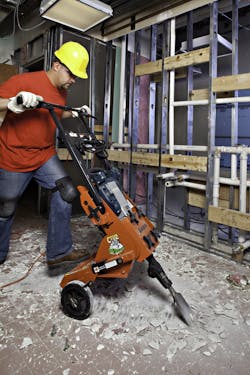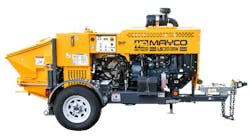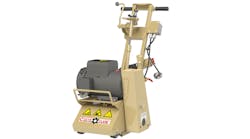Dennis Von Ruden, president, General Equipment
Trey Sklar, BU Manager – Power Tools and Accessories, Hilti
Scott Saunders, regional sales manager, CS Unitec
RER: What have been the primary innovations in concrete equipment during 2013 and what new developments do you expect in 2014?
Von Ruden: In my opinion, the last year has not seen a new wave of product innovation. Any innovation at the manufacturer’s level is usually fueled by two important factors:
1) Demand
2) Competition
We all know that product demand is prompted by marketplace conditions. Specifically, an increase or decrease in both residential and commercial construction usually defines the level of innovation at any given time. As a manufacturer, you can develop the most innovative product available and then introduce it to the market. But, if your customer base is operating in a depressed or uncertain economy, there could be the inability or reluctance to purchase. While certain segments of the economy are showing signs of positive growth, construction-related growth has been minimal or remains flat in many geographical areas of this country. A positive demand for product will be driven by a steady and predictable increase in concrete-related work activity.
Competition is what motivates us all to get out of bed each morning and work hard. When a concrete contractor is faced with using worn or obsolete equipment to compete against newer and far more productive equipment, the need to remain competitive is the driving force for new equipment acquisitions. As this demand grows, a proactive manufacturer realizes the need to provide the marketplace with innovation that better separates himself from his own competition.
I would expect 2014 to be very identical. Anything market positive will be driven by a demand fueled by economic confidence. Confidence breeds activity and growth.
Saunders: The biggest innovations in concrete tools are improved ergonomics and dust-extraction capabilities. Concrete contractors are demanding better power-to-weight ratios, improved ergonomics and dust extraction for cleaner and safer work environments. CS Unitec has an extensive line of concrete surface preparation tools, many featuring low-vibration operation and integrated dust-extraction shrouds. Whether you are grinding, cutting, or scarifying, our tools all have superior dust extraction capabilities when connected to an industrial dust-collection vacuum.
However, purchasing a high-performance tool with an excellent shroud and connecting it to a subpar vacuum is like driving an Indy Race Car filled with low-grade fuel. For the best results, a powerful industrial vacuum with or without HEPA filtration should be used. CS Unitec’s vacuums all deliver superior suction and filtration performance (HEPA and standard filtration models). Couple these vacuums with our properly shrouded tools and you now have a system that eliminates most, if not all, dust and debris. CS Unitec’s model CS 1225, introduced years ago and still selling/performing strong, was an innovation in self-cleaning vacuums. It was the first self-cleaning vacuum that, when switched to cleaning mode, would shake the filters to remove trapped dust. We now have the CS 1435 dust-extraction vacuum that automatically shakes the filters during operation for increased worker productivity. There is no longer a need to stop working to clean the filters.
Sklar: For years we have seen more and more applications move onto a cordless platform, but up until now the trend from corded to cordless has primarily been with smaller tool categories. 2013 saw the start of a new era as Hilti launched the TE 30-A36, the world’s first cordless combihammer. This 36V, 6Ah tool brings speed and power to heavy concrete drilling applications unmatched even by most corded combihammers, and gives users a level of mobility they have not experienced before. Going forward, we see future trends that help with productivity with increased speed and safety as key trends. An increased awareness of dust control, torque control (for drilling), and vibration reduction are also trends we see across multiple manufacturers, including Hilti.
What new trends are you seeing among concrete contractors as far as the kind of equipment they are looking for and the ways they do business?
Sklar: Contractors are looking for tools that give them productivity. This really comes down to two questions: Will this tool allow me to complete the application faster? Does this tool have the durability I need? There is a move to rent some of this equipment to minimize inventory that is not always needed, have access to the latest tools and have a ready fleet of products when the work comes.
Von Ruden: The answer to this question really never changes. Proactive contractors are always looking for new methods or processes that increase their productivity rates, lower their direct labor rates and provide an end product that increases customer satisfaction levels.
- Productivity Rates. Contractors are continually faced with increasing their productivity rates because of bidding pressure. Any machine or process that decreases the time required to complete a task adds to the bottom line profits. Especially if the process requires a higher skill level.
- Labor Costs. There is no surplus of skilled workers for any given job process in this country. The acute shortage of skilled workers is well documented. Every proactive contractor is searching for how to do more with less. Less investment. Less people. Less cost.
- Increased Customer Satisfaction. Expectation levels remain high. Today’s customers are demanding higher satisfaction levels for any work performed. Concrete is expected to be stronger. Crack less. Be more decorative. Add more value. The contractor that strives to deliver all that to his customers will eventually reap the benefits of his endeavors.
It should be noted that the factors noted above are not unique or limited just to the concrete contractor. They apply also to the rental dealer and the equipment manufacturer. What changes is how each segment engages and attempts to provide cost-effective solutions.
What innovations are you seeing in air quality, i.e. dust-control and other such areas?
Von Ruden: The general expectation is that any product used today to scarify, grind, polish or demolish concrete needs to also incorporate some type of dust containment system. But, not only is it important that it utilize a dust containment system, it also needs to be efficient in capturing the highest percentage possible.
One obstacle is getting the contractor’s people to understand the importance of properly utilizing the dust-containment system. The perception is that:
- It requires too much additional time and effort to use.
- There’s no real, visible difference using it.
- It won’t affect me if I don’t use it…I’ll live forever!
Sklar: Dust and, to a lesser extent, vibrations are becoming a much more important topic. Regulations (including the recently proposed OSHA rule) and job-specific requirements now often include dust control and vibration reduction. We see opportunities to provide “engineered systems,” which are integrated dust control systems mounted directly to the tools. These systems often allow the contractor to maintain a higher level of productivity without having to manually clean up the dust or seal off the jobsite.
In most equipment areas, rental penetration is increasing. Do you see that in concrete-related equipment?
Saunders: Our rental partners have stepped up and purchased more concrete tools to expand their offering to meet the ever-evolving needs of concrete contractors. This increase can be attributed to a variety of factors, a few of which include: tools designed for more efficient operation; improved ergonomics for operator comfort and safety; and simply an increase in demand and business growth. For example, 5-piston scabblers have historically been very large and heavy and did not include dust extraction. Our Trelawny MHS5 Scabbler is much smaller and has an integrated vacuum shroud and port. This tool is very popular with the rental houses because it is unique, very durable and has associated consumables. Our 11-head scabbler also includes an integrated vacuum shroud and port, as well as low-vibration operation for operator comfort and safety.
Von Ruden: The rental penetration rate is directly related to market demand. Both by the professional contractor and DIY customer, alike. When residential and commercial concrete construction increases, the contractor is faced with several questions. Do I have the equipment that makes me competitive? If not, am I ready to purchase new or is the most economical alternative to rent until market stability allows for the purchase option. Obviously, not every concrete contractor can justify a decision to purchase new or additional equipment for any given job and many times the rental option makes the most economic sense.
The rental dealer also has some important decisions to make. Does he have a fleet that offers his customers a competitive advantage? Has his fleet aged to the point where he can no longer offer an advantage against competitive rental dealers? Does market stability provide him with the economic confidence to purchase new equipment? Whatever that decision is, it will have a direct impact upon the equipment manufacturer. If the rental dealer does not have the confidence to purchase new equipment, the manufacturer will not see the sale.
Realistically, all three parties, the concrete contractor, the rental dealer and the manufacturer are all bound together by the same economic conditions and resulting levels of purchasing confidence. Confidence is the common, motivating force because it is what drives the initial decision to contract for some type of concrete-related work. After that decision is made, it eventually triggers an economic impact upon all three parties.
Are you optimistic about the economic environment in the coming years? What economic trends do you expect?
Von Ruden: Until the concrete-related market experiences steady and improving growth, there will be minimal, at best, confidence at the contractor and dealer levels to make a substantial investment in new and more innovative inventory. But what drives the contractor is the confidence held by homeowners and commercial developers. Ultimately these types of decisions will directly affect sales volume for those affected manufacturers. The construction marketplace was one of the first to be affected by the economic downturn. Unfortunately for the rental industry, it will also probably be one of the last to fully rebound.
Saunders: We are optimistic about the economy. When you provide unique high-quality, high-performance application-driven tools, your products are needed in a wide variety of industries. Rental houses have been great customers of ours because our tools are low maintenance, perform reliably and exceed the demands of the concrete contractor.
Sklar: We are optimistic. Market growth numbers for 2014 look better than we have seen in years and contractors are seeing their work load increase.







